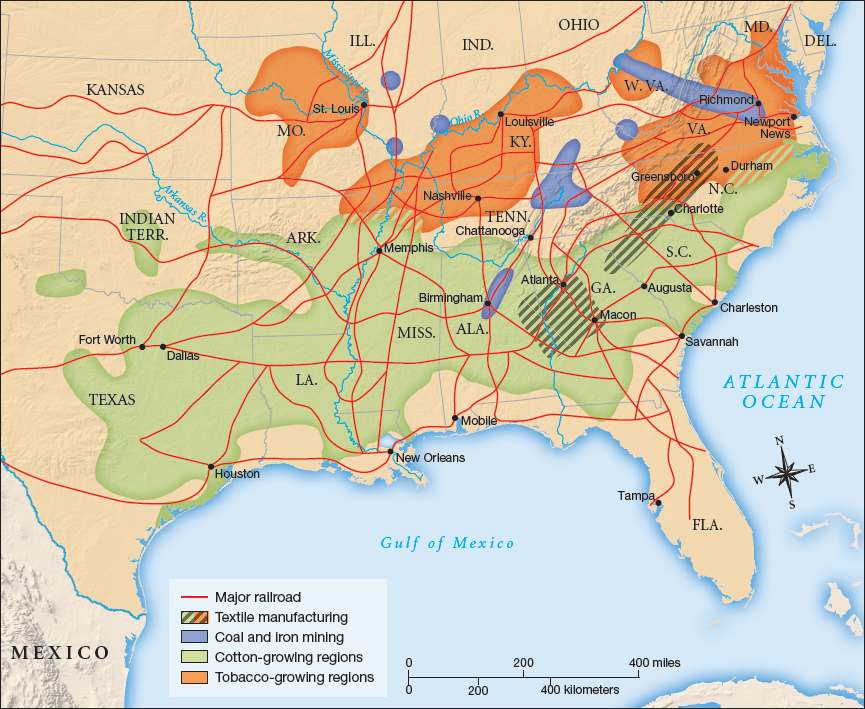Exploring American Histories: Printed Page 497
Exploring American Histories, Value Edition: Printed Page 408
Building a New South
Although the largely rural South lagged behind the North and the Midwest in manufacturing, industrial expansion did not bypass the region. Well aware of global economic trends and eager for the South to achieve its economic potential, southern business leaders and newspaper editors, especially the Atlanta Constitution’s editor Henry Grady, saw industrial development as the key to the creation of a New South. Attributing the Confederate defeat in the Civil War to the North’s superior manufacturing output and railroad supply lines, New South proponents hoped to modernize their economy in a similar fashion. One of those boosters was Richard H. Edmonds, the Virginia-born editor of the Manufacturers’ Record. He extolled the virtues of the “real South” of the 1880s, characterized by “the music of progress—the whirr of the spindle, the buzz of the saw, the roar of the furnace, the throb of the locomotive.” The South of Edmonds’s vision would move beyond the regional separatism of the past and become fully integrated into the national economy.
Railroads were the key to achieving such economic integration, so after the Civil War new railroad tracks were laid throughout the South. Not only did this expanded railroad system create direct connections between the North and the South, but it also facilitated the growth of the southern textile industry. Seeking to take advantage of plentiful cotton, cheap labor, and the improved transportation system, investors built textile mills throughout the South, especially in the Carolinas and Georgia. Victims of falling prices and saddled with debt, sharecroppers and tenant farmers moved into mill towns in search of better employment. Mill owners preferred to hire girls and young women, who worked for low wages, to spin cotton and weave it on the looms. To do so, however, owners had to employ their entire family, for mothers and fathers would not let their daughters relocate without their supervision. Whatever attraction the mills offered applied only to whites. The pattern of white supremacy emerging in the post-Reconstruction South kept African Americans out of all but the most menial jobs.
Blacks contributed greatly to the construction of railroads in the New South, but they did not do so as free men. Convicts, most of whom were African American, performed the exhausting work of laying tracks through hills and swamps. Southern states used the convict lease system, in which blacks, usually imprisoned for minor offenses, were hired out to private companies to serve their time or pay off their fine. The convict lease system brought additional income to the state and supplied cheap labor to the railroads and planters, but it left African American convict laborers impoverished and virtually enslaved. See e-Document Project 16: Labor and Race in the New South.
The South attracted a number of industries besides textile manufacturing. In the 1880s, James B. Duke established a cigarette manufacturing empire in Durham, North Carolina. Nearby tobacco fields provided the raw material that black workers prepared for white workers, who then rolled the cigarettes by machine. Acres of timber pines in the Carolinas, Florida, and Alabama sustained a lucrative lumber industry, one of the few to employ whites and blacks equally. Rich supplies of coal and iron in Alabama fostered the growth of the steel industry in Birmingham, which produced more than a million tons of steel at the turn of the twentieth century (Map 16.1).

Despite this frenzy of industrial activity, the New South in many ways resembled the Old South. Southern entrepreneurs still depended on northern investors to supply much of the capital for investment. Investors were attracted by the low wages that prevailed in the South, but low wages also meant that southern workers remained poor and, in many cases, unable to buy the manufactured goods produced by industry. Efforts to diversify agriculture beyond tobacco and cotton were constrained by a sharecropping system based on small, inefficient plots. In fact, even though industrialization did make considerable headway in the South, the economy remained overwhelmingly agricultural. This suited many white southerners who wanted to hold on to the individualistic, agrarian values they associated with the Old South. In this way, they sought to remain distinct from what they considered the acquisitive North. Yoked to old ideologies and a system of forced labor, modernization in the South could go only so far.